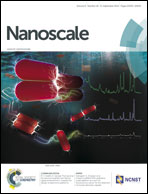Size-controlled SnO2 hollow spheres via a template free approach as anodes for lithium ion batteries†
Abstract
Tin oxide hollow spheres (SnO2 HS) with high structural integrity were synthesized by using a one pot hydrothermal approach with organic moieties as structure controlling agents. By adjusting the proportion of acetylacetone (AcAc) in the precursor formulation, SnO2 HS of 200 and 350 nm dimensions, with a uniform shell thickness of about 50 nm, were prepared. Using the optimized solution composition with a Sn precursor, heating duration dependent structural evolution of SnO2 was performed at a fixed temperature of 160 °C, which revealed a transition from solid spheres (1 h) to aggregated spheres (4 h) to porous spheres (10 h) to optimized HS (13 h) and finally to broken enlarged HS (24 h). A heating temperature dependent study carried out with a constant heating span of 13 h showed a metamorphosis from spheres with solid cores (140 °C) to ones with hollow cores (160 °C), culminating with fragmented HS, expanded in dimensions (180 °C). A growth mechanism was proposed for the optimized SnO2 HS (2.5 or 5.0 mL of AcAc, 160 °C, 13 h) and the performance of these HS as anodes for Li ions batteries was evaluated by electrochemical studies. The 200 nm SnO2 HS demonstrated an initial lithium storage capacity of 1055 mA h g−1 at a current density of 100 mA g−1, and they retained a capacity of 540 mA h g−1 after 50 charge–discharge cycles. The SnO2 HS also showed excellent rate capability as the electrode exhibited a capacity of 422 mA h g−1 even at a high current density of 2000 mA g−1. The notable capacity of SnO2 HS is a manifestation of the mono-disperse quality of the SnO2 HS coupled with the high number of electrochemically addressable sites, afforded by the large surface area of the HS and the striking cyclability is also attributed to the unique structure of HS, which is resistant to degradation upon repeated ion insertion/extraction. The SnO2 HS were also found to be luminescent, thus indicating their usefulness for not only energy storage but also for energy harvesting applications.


 Please wait while we load your content...
Please wait while we load your content...